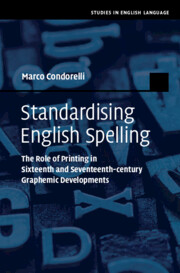 Standardising English Spelling
Standardising English Spelling from Part III - Case Studies
Published online by Cambridge University Press: 31 March 2022
Chapter 9 focuses on the analysis of etymological spelling, and especially the insertion of <b>, <c>, <d>, <l> and <p> in Early Modern English word forms, the development of alternant <aun> and <ph>, and the rationalisation of <er>/<ar>. My results indicate that etymologised spellings appeared increasingly more markedly between the early and the mid-sixteenth century, while only a percentage of the forms which developed during these decades continued until the seventeenth century. My investigation shows that the etymologising developments in epenthetic graphemes, <aun>, <ph> and <er>/<ar> spread out not gradually, from high-frequency words to lower-frequency ones, but rather at largely comparable frequencies across most of the English vocabulary, albeit somewhat erratically and haphazardly across legitimate and illegitimate etymologies. The discussion reflects upon the development of the etymological spellings, focusing especially on the potential interaction between authors and printers as agents responsible for the modern standardisation during the process of in-house proofreading. Overall, I suggest, changes occurring in the English printing industry were primarily responsible for the different etymologising trends between the sixteenth and the seventeenth centuries.
To save this book to your Kindle, first ensure [email protected] is added to your Approved Personal Document E-mail List under your Personal Document Settings on the Manage Your Content and Devices page of your Amazon account. Then enter the ‘name’ part of your Kindle email address below. Find out more about saving to your Kindle.
Note you can select to save to either the @free.kindle.com or @kindle.com variations. ‘@free.kindle.com’ emails are free but can only be saved to your device when it is connected to wi-fi. ‘@kindle.com’ emails can be delivered even when you are not connected to wi-fi, but note that service fees apply.
Find out more about the Kindle Personal Document Service.
To save content items to your account, please confirm that you agree to abide by our usage policies. If this is the first time you use this feature, you will be asked to authorise Cambridge Core to connect with your account. Find out more about saving content to Dropbox.
To save content items to your account, please confirm that you agree to abide by our usage policies. If this is the first time you use this feature, you will be asked to authorise Cambridge Core to connect with your account. Find out more about saving content to Google Drive.